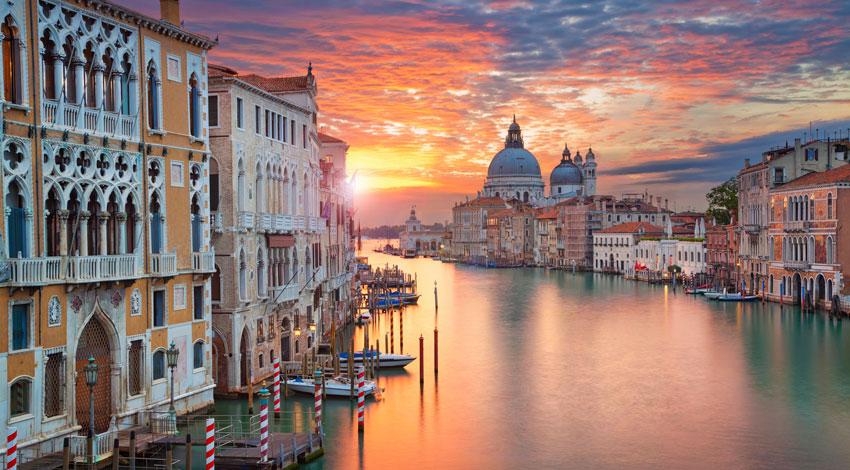Campus of the Year Featured Region: Venice
In celebration of our 2023 Campus of the Year, we will be regularly sharing stories, recipes and recommendations about Italy! From its history and culture to a few of our favorite learning adventures, follow along to learn more about this fascinating country all year long!
Home to timeless beauty and rich art and culture, Venice is an iconic city to learn in and explore. From its classic canals to its stunning marbled architecture, there’s something new to discover tucked around every corner of Venice.
Here are just a few things you should know about this amazing city!

What You Can Expect to See
Venice is located in northern Italy and serves as the capital of the northern region Veneto. The city is packed with world-class architecture, art galleries and mouthwatering cuisine. As you travel along canals and hidden backstreets, you’ll have the chance to immerse yourself in Italian history and culture through experiences like:
- Enjoying the St. Mark’s Basilica at night, when its beauty can be experienced without crowds.
- Delighting in the musical offerings of Venice during an evening concert.
- Visiting classic Venetian landmarks like the Grand Canal and the Doge’s Palace.
What You Should Eat
There are plenty of local dishes to try while wandering around Venice! One is risi e bisi, or Venetian-style rice and peas traditionally served on St. Mark’s Day. This dish lands in the middle of rice and soup, made with hearty and simple ingredients. Due to Venice’s proximity to the ocean, seafood is also a popular dish, especially tender crabmeat.
And if you’re looking for a sweet treat, you simply can’t leave Venice without sampling some gelato!Getting Around
No matter which part of Italy you explore, walking will be an integral part of your experience. Bring along comfortable, sturdy shoes to navigate the many cobblestones and rail-less stairways you may encounter. While your bus will bring you as close as possible to the landmarks you have dreamed of exploring, many of these locations prohibit vehicles from getting too close and you will need to walk the remainder of the way.
Pro tip: if you have mobility issues, bring along a mobile cane chair to help you navigate uneven pathways and offer you a place to sit and rest when needed.

What to Bring
Fashion in Italy is important, but it is also important to dress smart. Religious sites have staff enforcing dress codes requiring covered knees and shoulders. It is also wise to purchase a body wallet to prevent your passport, money and other valuables from being stolen by professional pickpockets. Carrying a small crossbody bag, worn to your front, zipped shut and held with one hand, can prevent theft.
Especially during the summer months, having water on hand is a good idea. Rather than purchasing plastic bottled water, bring your own reusable water bottle to retrieve fresh potable water from one of the many water fountains. Clean drinking water from the local mountains is readily available across most regions in Italy.
Pro tip: Prepare for your learning adventure with a book from our Italy booklist!
Have Free Time? Be Sure to Check Out...
The Peggy Guggenheim Collection
Displaying Peggy Guggenheim’s personal art collection, this museum features 20th century European and American art in Peggy’s former home along the Grand Canal. The collection includes a variety of artwork, including works by Picasso and Pollock.
Piazza San Marco
Surrounded by shops, cafes and iconic architecture, Piazza San Marco, or St. Mark’s Square, is a must-see for travelers to Venice. Besides serving as a notable gathering place within the city, structures such as the Campanile (a 324-foot bell tower) and the Old Library also reside near the Piazza. The library contains relics of Venice’s past as a publishing and cartographic center.
Academy Gallery (Gallerie dell'Accademia)
This former academy was turned into a museum by Napoléon himself. Its art collection includes work from the 14th-18th centuries by artists like Bellini and Veronese. With a strong emphasis on Renaissance art, art history enthusiasts will enjoy walking through its halls.
